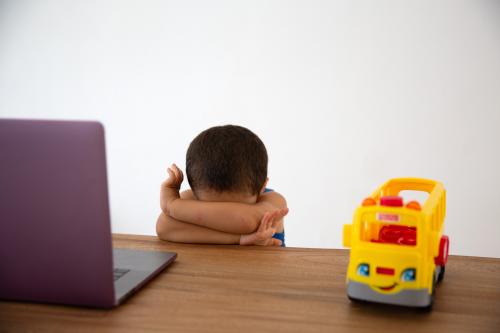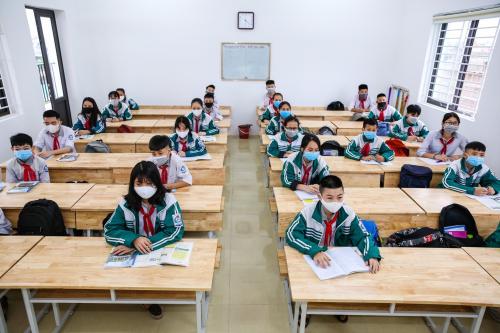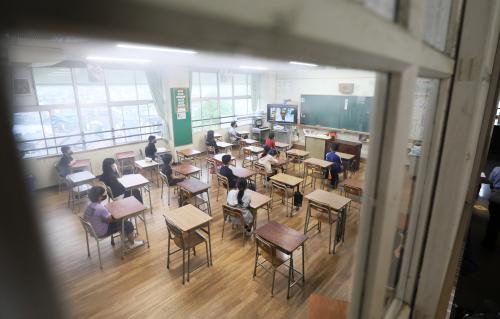COVID-19-related school closures are forcing countries even further off track from achieving their learning goals. The students currently in school stand to lose $10 trillion in labor earnings over their work life. To get a sense of the magnitude, this sum is one-tenth of global GDP, or half of the annual economic output of the United States, or twice the global annual public expenditure on primary and secondary education.
Temporary closures in more than 180 countries have kept nearly 1.6 billion students out of school, further complicating global efforts to reduce learning poverty. While most countries have made heroic efforts at putting in place remote and remedial learning strategies, learning losses are accumulating rapidly. A recent survey from UNICEF-UNESCO-World Bank on national education responses to COVID-19 school closures shows that while the response across countries and regions varies, it has been difficult to reach even half of all students (Figure 1). Despite vigorous initiatives in Bangladesh, for example, take-up of remote learning is only in the single digits.
There are studies to measure learning losses directly, such as methodological work on phone-based assessments in Botswana and Pakistan. But the global community will need to wait many months—if not years—for a complete picture of global learning losses. In the meantime, many important decisions about funding, school reopenings, and teaching strategies have to be made. To inform these decisions, we have developed simulations of the effects of school closures lasting three (optimistic), five (intermediate), or seven months (pessimistic) with varying degrees of effectiveness of mitigation measures. Our results add to information from previous simulation exercises such as these from RISE and RTI International.
Figure 1. Remote learning strategies vary across country income groups and educational levels
How do we get to $10 trillion?
In our intermediate scenario, schools are closed for five months. These are the estimates that we find most likely, given that most school systems closed in March, and—though there are exceptions—we see many countries planning to reopen after the summer. In this scenario, we expect to see a global loss of 0.6 learning-adjusted years of schooling (LAYS), making the global average fall from 7.9 LAYS to 7.3 LAYS. Being out of school for that long means that children not only stop learning, they also tend to forget a lot of what they have learned.
We use the PISA global database to estimate how learning levels could be affected. The closures could result in an average of 16 points of lost learning in terms of PISA scores for lower secondary students. They could increase the share of students not acquiring minimum proficiency from 40 to 50 percent (Figure 2). An estimated 7 million students are likely to drop out of school. The effects on girls and vulnerable and marginalized groups will likely be much worse.
Figure 2. The share of children below minimum proficiency is likely to increase by 25%
To gauge the long-term economic impacts of these learning losses, we projected how they could affect future earnings. In our intermediate scenario, a typical student’s future earnings will fall by $872 a year, reaching a total loss of $16,000 in lifetime earnings in present value terms. Using global data on household labor incomes, we allow these results to vary by country. We then add up the country-level results for all learners who are enrolled in primary and secondary education in the world. Combined, this generation of students stands to lose an estimated $10 trillion in earnings over its work life.
How do our figures compare with other estimates? For students who are expected to work, we estimate an income loss of 5 percent of lifetime earnings. In the United Kingdom, economists predict an earnings loss of 3 percent of yearly income. In the United States, one study forecasts a loss of 2-2.5 percent of income, another up to 13 percent of the U.S. current GDP. Our estimates for the world as a whole are comparable in severity, despite slightly different methodological approaches.
The relative impacts of these losses on low-income countries (LICs) are higher when measured in terms of their public investment in basic education. LICs could lose more than three full years of their investment in basic education; high-income countries stand to lose less than two years of their investment. This underscores the especially urgent need to protect investments in education in the poorest countries. We know that human capital investments power long-run economic development. Governments and development partners need to immediately step up efforts to protect and increase investments in people.
How to recover and accelerate learning
As outlined in our recent education policy response, governments would do better if they plan their actions in three phases: coping, managing continuity, and improving and accelerating. In deciding and preparing for reopening of schools, they should consult with their communities, teachers, parents, and students to understand and address their concerns. They should assess the safety of operations, developing clear protocols for hygiene and social distancing as described in “Framework for Reopening Schools.” In many settings, basic infrastructure for handwashing and hygiene will need to be put in place. They should also increase investments and teacher training in remote learning and accelerated learning recovery.
While actions have to be tailored to each context, a common focus ought to be strengthening the capacity of schools to reduce risks of disease transmission and promote healthy behavior. Health and safety concerns may require managing the number of on-site students through double shifts, targeting early grades and vulnerable groups, and combining in-person instruction with remote learning. There should also be a focus on recovering lost learning by assessing learning loss, supporting socioemotional well-being, and targeted remedial measures. Also needed are loud reenrollment campaigns and cash transfers to make sure that school systems do not lose children permanently. Governments and school leaders also need to pay special attention to protecting vulnerable groups. Given the high risks of increased disparities, marginalized students must be a high priority in COVID-19 education response strategies. Students below and near minimum learning proficiency deserve special attention.
As challenging as COVID-19 is for education, it can be transformed into a watershed event for building more equitable and resilient education systems. Recovery from COVID-19 offers the opportunity to reimagine educational systems—using technology to improve outcomes, addressing inequality, and reducing learning poverty. It has long been clear that education and schools need to change to prepare children for the future and ensure that all children are learning. The investments being made now in remote learning—in multimedia content, remote training and support of teachers, and remote learning assessments—can be a launchpad for more personalized ways of providing education.
Reimagined education systems must eventually be able to individualize instruction. They should be able to provide compensatory learning to rapidly recover the learning lost to school closures or student dropout. They will need to work hard to integrate learning in the classroom and remote learning, enabling children to learn well both in school and at home. If they do all this, policymakers will not only be prepared to smooth interruptions in learning during this and future pandemics but also build today the education systems of the future.
For more on the simulations and their assumptions and results, see “Simulating the Potential Impacts of the COVID-19 School Closures on Schooling and Learning Outcomes: A set of Global Estimates.” See the “Framework for Reopening Schools” for guidelines that aim to inform the decisionmaking process regarding school reopening, support national preparations, and guide the implementation process as part of overall public health and education planning processes.













Commentary
Learning losses due to COVID-19 could add up to $10 trillion
July 30, 2020